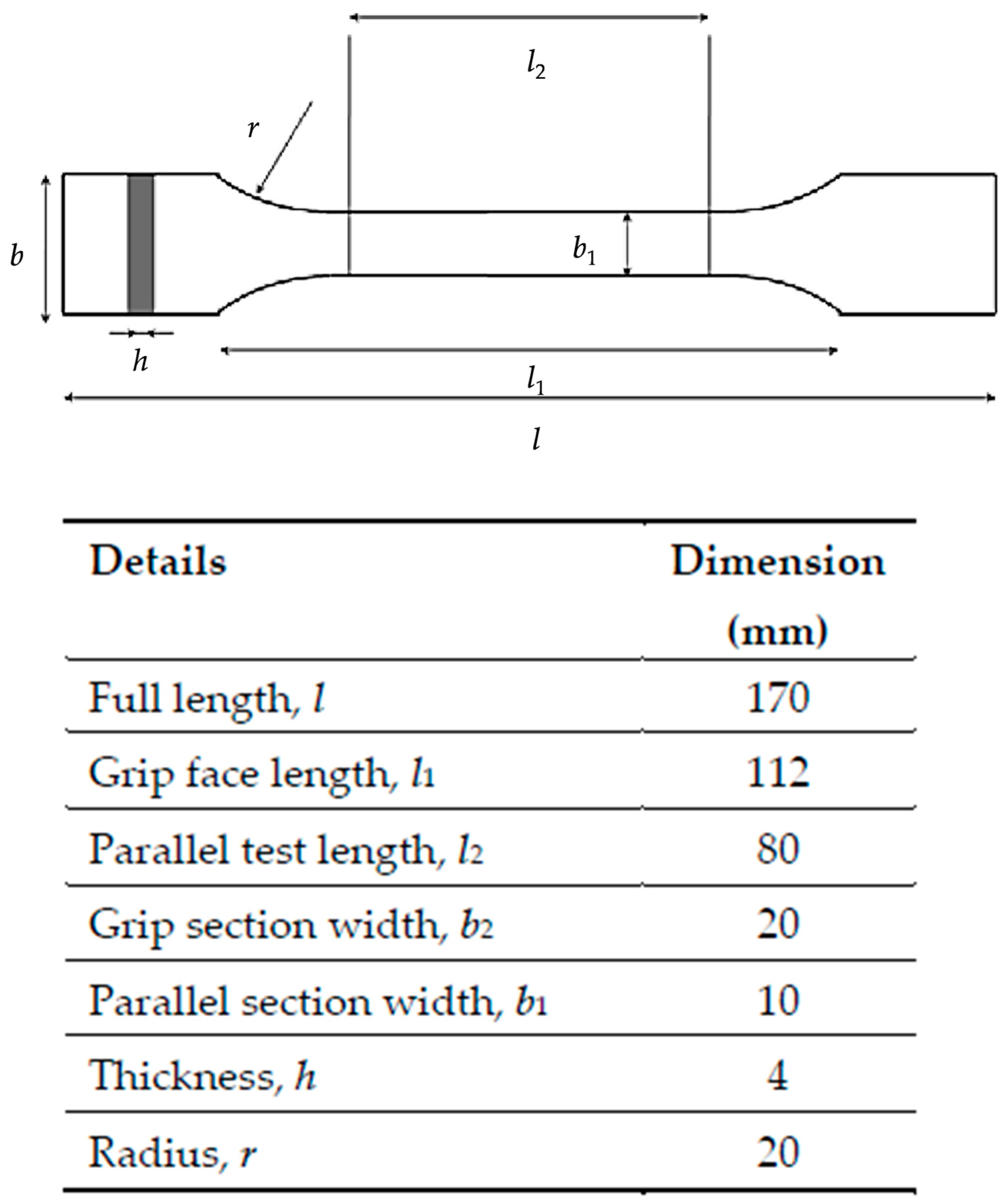Comparative Screening of the Structural and Thermomechanical Properties of FDM Filaments Comprising Thermoplastics Loaded with Cellulose, Carbon and Glass Fibers
Abstract
1. Introduction
2. Materials and Methods
2.1. Thermoplastic Polymer Composite Filaments for Additive Manufacturing
2.2. Thermogravimetric Analysis and Differential Scanning Calorimetry
2.3. Mechanical and Thermal Characterization Procedure
2.4. Optical Measurement Systems
3. Results
3.1. Thermoplastic Polymer Composite Filaments for Additive Manufacturing
3.2. Tensile Tests and IR Thermography
3.3. Optical Measurements
4. Conclusions
Author Contributions
Funding
Acknowledgments
Conflicts of Interest
References
- Holmes, M. Additive manufacturing continues composites market growth. Reinf. Plast. 2019, 63, 296–301. [Google Scholar] [CrossRef]
- Sireesha, M.; Lee, J.; Kiran, A.S.K.; Babu, V.J.; Kee, B.B.T.; Ramakrishna, S. A review on additive manufacturing and its way into the oil and gas industry. RSC Adv. 2018, 8, 22460–22468. [Google Scholar] [CrossRef]
- Wohlers, T. Additive manufacturing and composites: An update. Composites World 2017, 3, 6. [Google Scholar]
- Schoffer, F. Is 3D Printing the Next Industrial Revolution? Available online: http://tcrn.ch/1TJk5rL (accessed on 10 December 2019).
- Keleş, Ö.; Anderson, E.H.; Huynh, J.; Gelb, J.; Freund, J.; Karakoç, A. Stochastic fracture of additively manufactured porous composites. Sci. Rep. 2018, 8, 15437. [Google Scholar] [CrossRef]
- Yasa, E.; Ersoy, K. A Review on the Additive Manufacturing of Fiber Reinforced Polymer Matrix Composite. In Proceedings of the 29th Annual International Solid Freeform Fabrication Symposium, Austin, TX, USA, 13–15 August 2018; pp. 1024–1033. [Google Scholar]
- Rahim, T.N.A.T.; Abdullah, A.M.; Akil, H.M. Recent Developments in Fused Deposition Modeling-Based 3D Printing of Polymers and Their Composites. Polym. Rev. 2019, 59, 589–624. [Google Scholar] [CrossRef]
- Parandoush, P.; Lin, N. A review on additive manufacturing of polymer-fiber composites. Compos. Struct. 2017, 182, 36–53. [Google Scholar] [CrossRef]
- Gibbons, J.H. Advanced Materials by Design; DIANE Publishing: Collingdale, PA, USA, 1988. [Google Scholar]
- Frketic, J.; Dickens, T.; Ramakrishnan, S. Automated manufacturing and processing of fiber-reinforced polymer (FRP) composites: An additive review of contemporary and modern techniques for advanced materials manufacturing. Addit. Manuf. 2017, 14, 69–86. [Google Scholar] [CrossRef]
- Pickering, K.; Stoof, D. Sustainable Composite Fused Deposition Modelling Filament Using Post-Consumer Recycled Polypropylene. J. Compos. Sci. 2017, 1, 17. [Google Scholar] [CrossRef]
- Poelma, J.; Rolland, J. Rethinking digital manufacturing with polymers. Science 2017, 358, 1384–1385. [Google Scholar] [CrossRef]
- Zhao, F.; Li, D.C.; Jin, Z.M. Preliminary Investigation of Poly-Ether-Ether-Ketone Based on Fused Deposition Modeling for Medical Applications. Materials 2018, 11, 288. [Google Scholar] [CrossRef]
- Bui, Q. The Study on the Influence of the 3D Printing Parameters on the Mechanical Properties of Products; Arcada University of Applied Sciences: Helsinki, Finland, 2018. [Google Scholar]
- Ultimaker. Available online: https://ultimaker.com/ (accessed on 10 December 2019).
- Octofiber. Available online: https://octofiber.com/ (accessed on 10 December 2019).
- UPM Formi 3D. Available online: https://www.upmformi.com/3D-printing/Documents/UPM-Formi-3D-Product-Data-Sheet-EN.pdf (accessed on 10 December 2019).
- Owens-Corning. Available online: https://www.owenscorning.com/ (accessed on 10 December 2019).
- Carbodeon. Available online: https://carbodeon.com/ (accessed on 10 December 2019).
- Innofil3D. Available online: https://www.innofil3d.com/ (accessed on 10 December 2019).
- Hausman, K.K.; Horne, R. 3D Printing for Dummies; For Dummies; Wiley: Hoboken, NJ, USA, 2014; ISBN 9781118660775. [Google Scholar]
- Cantrell, J.T.; Rohde, S.; Damiani, D.; Gurnani, R.; DiSandro, L.; Anton, J.; Young, A.; Jerez, A.; Steinbach, D.; Kroese, C.; et al. Experimental characterization of the mechanical properties of 3D-printed ABS and polycarbonate parts. Rapid Prototyp. J. 2017, 23, 811–824. [Google Scholar] [CrossRef]
- EN ISO 527-1. Plastics—Determination of Tensile Properties—Part 1: General Principles; International Organization of Standardization: Geneva, Switzerland, 2012. [Google Scholar]
- 3D Solex. Available online: https://3dsolex.com/product/um3-hardcore/ (accessed on 10 December 2019).
- Lafranche, E.; Oliveira, V.M.; Martins, C.I.; Krawczak, P. Prediction of injection-moulded flax fibre reinforced polypropylene tensile properties through a micro-morphology analysis. J. Compos. Mater. 2015, 49, 113–128. [Google Scholar] [CrossRef]
- Ma, Y.; Zhou, T.; Su, G.; Li, Y.; Zhang, A. Understanding the crystallization behavior of polyamide 6/polyamide 66 alloys from the perspective of hydrogen bonds: Projection moving-window 2D correlation FTIR spectroscopy and the enthalpy. RSC Adv. 2016, 6, 87405–87415. [Google Scholar] [CrossRef]
- Chen, T.; Jiang, G.; Li, G.; Wu, Z.; Zhang, J. Poly(ethylene glycol-co-1,4-cyclohexanedimethanol terephthalate) random copolymers: Effect of copolymer composition and microstructure on the thermal properties and crystallization behavior. RSC Adv. 2015, 5, 60570–60580. [Google Scholar] [CrossRef]
- Coppola, B.; Cappetti, N.; Di Maio, L.; Scarfato, P.; Incarnato, L. 3D Printing of PLA/clay Nanocomposites: Influence of Printing Temperature on Printed Samples Properties. Materials 2018, 11, 1947. [Google Scholar] [CrossRef]
- Geng, P.; Zhao, J.; Wu, W.; Wang, Y.; Wang, B.; Wang, S.; Li, G. Effect of Thermal Processing and Heat Treatment Condition on 3D Printing PPS Properties. Polymers 2018, 10, 875. [Google Scholar] [CrossRef]
- Jia, S.; Yu, D.; Zhu, Y.; Wang, Z.; Chen, L.; Fu, L. Morphology, Crystallization and Thermal Behaviors of PLA-Based Composites: Wonderful Effects of Hybrid GO/PEG via Dynamic Impregnating. Polymers 2017, 9, 528. [Google Scholar] [CrossRef]
- Millot, C.; Fillot, L.A.; Lame, O.; Sotta, P.; Seguela, R. Assessment of polyamide-6 crystallinity by DSC. J. Therm. Anal. Calorim. 2015, 122, 307–314. [Google Scholar] [CrossRef]
- Liu, X.; Lai, D.; Liu, Y.; Shi, P.; Wang, W.; Tan, J.; Mao, L.; Yang, J. Structure and properties of PA6-66/γ-aminopropyltriethoxysilane-modified clay nanocomposites prepared by in situ polymerization. J. Polym. Eng. 2018, 39, 16–24. [Google Scholar] [CrossRef]
- Khan, S.; Zakaria, H.; Chong, Y.; Saad, M.A.M.; Basaruddin, K. Effect of infill on tensile and flexural strength of 3D printed PLA parts. In Proceedings of the IOP Conference Series: Materials Science and Engineering; IOP Publishing: Bristol, UK, 2018; Volume 429, p. 012101. [Google Scholar]
- Lezak, E.; Kulinski, Z.; Masirek, R.; Piorkowska, E.; Pracella, M.; Gadzinowska, K. Mechanical and Thermal Properties of Green Polylactide Composites with Natural Fillers. Macromol. Biosci. 2008, 8, 1190–1200. [Google Scholar] [CrossRef]
- El-Hadi, A.M. Investigation of the effect of nano-clay type on the non-isothermal crystallization kinetics and morphology of poly(3(R)-hydroxybutyrate) PHB/clay nanocomposites. Polym. Bull. 2014, 71, 1449–1470. [Google Scholar] [CrossRef]
- Rwei, S.P.; Ranganathan, P.; Lee, Y.H. Isothermal Crystallization Kinetics Study of Fully Aliphatic PA6 Copolyamides: Effect of Novel Long-Chain Polyamide Salt as a Comonomer. Polymers 2019, 11, 472. [Google Scholar] [CrossRef] [PubMed]
- Vaezi, M.; Yang, S. Extrusion-based additive manufacturing of PEEK for biomedical applications. Virtual Phys. Prototyp. 2015, 10, 123–135. [Google Scholar] [CrossRef]
- Valentan, B.; Kadivnik, Ž.; Brajlih, T.; Anderson, A.; Drstvenšek, I. Processing poly(ether etherketone) on a 3d printer for thermoplastic modelling. Mater. Tehnol. 2013, 47, 715–721. [Google Scholar]
- Dawoud, M.; Taha, I.; Ebeid, S.J. Mechanical behaviour of ABS: An experimental study using FDM and injection moulding techniques. J. Manuf. Process. 2016, 21, 39–45. [Google Scholar] [CrossRef]
- Blok, L.; Longana, M.; Yu, H.; Woods, B. An investigation into 3D printing of fibre reinforced thermoplastic composites. Addit. Manuf. 2018, 22, 176–186. [Google Scholar] [CrossRef]
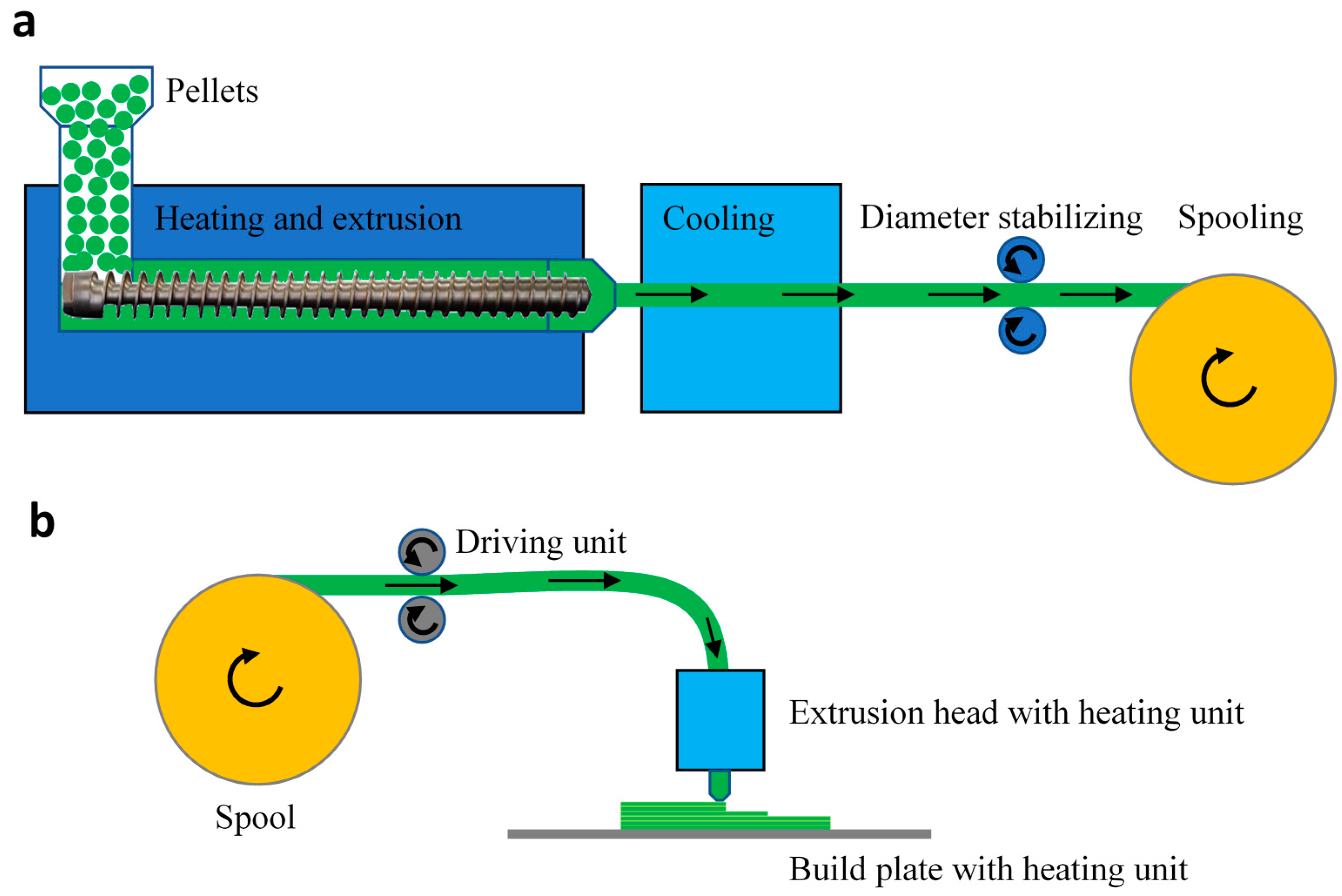
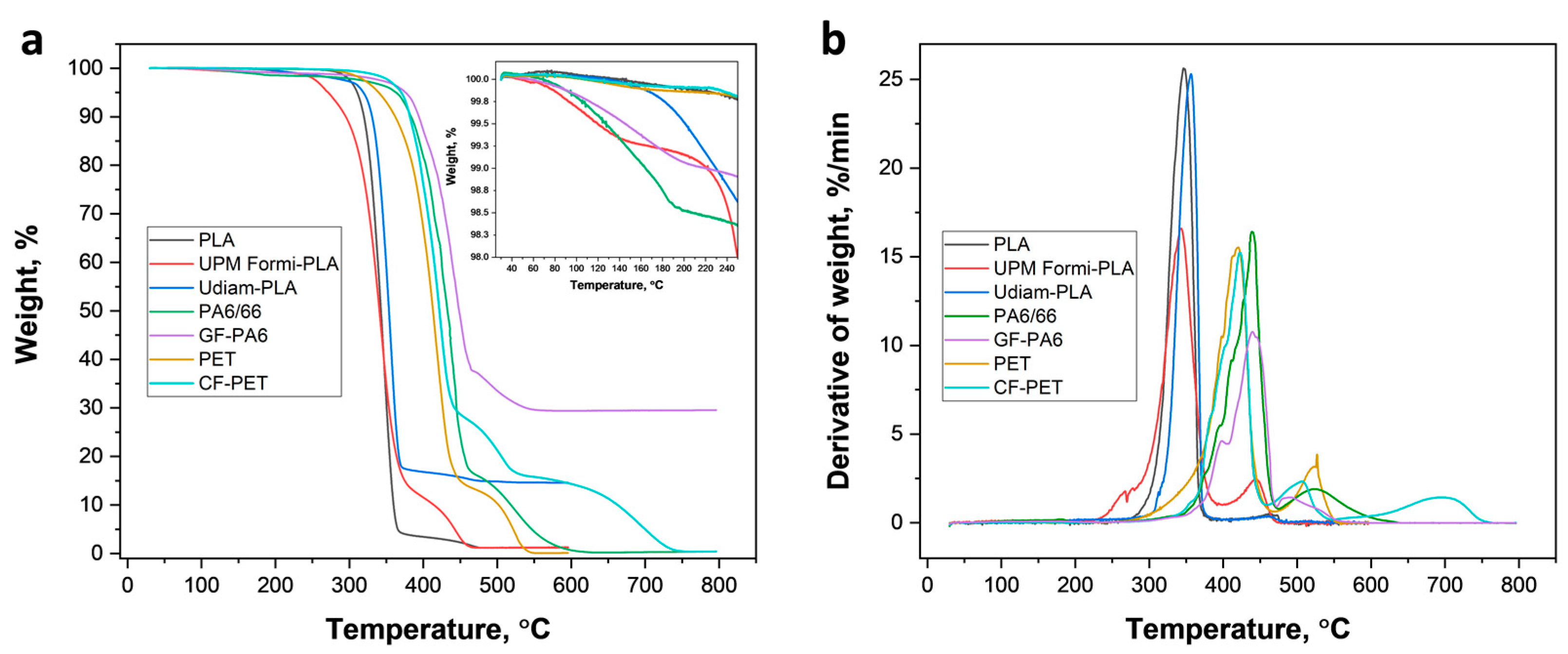
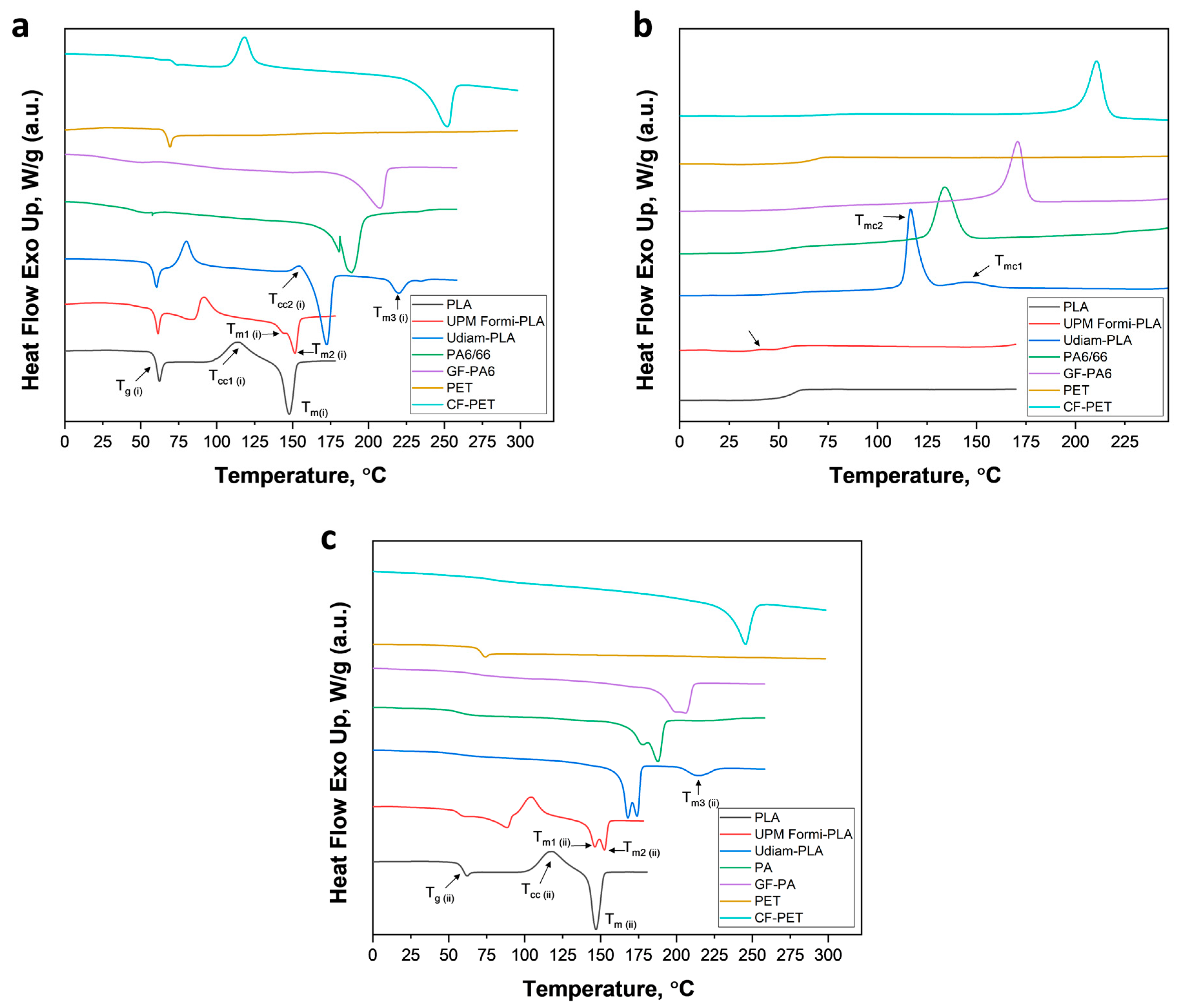
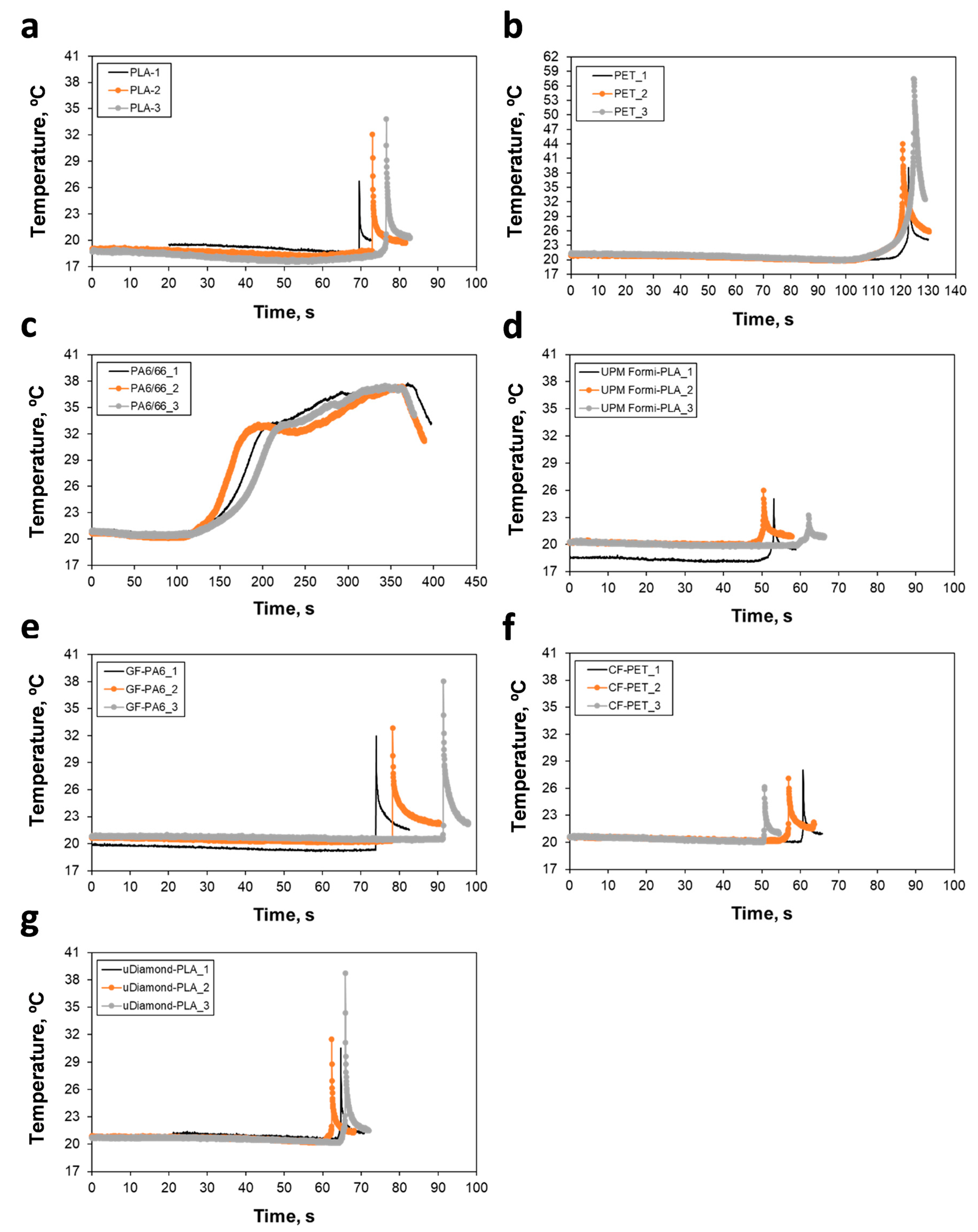
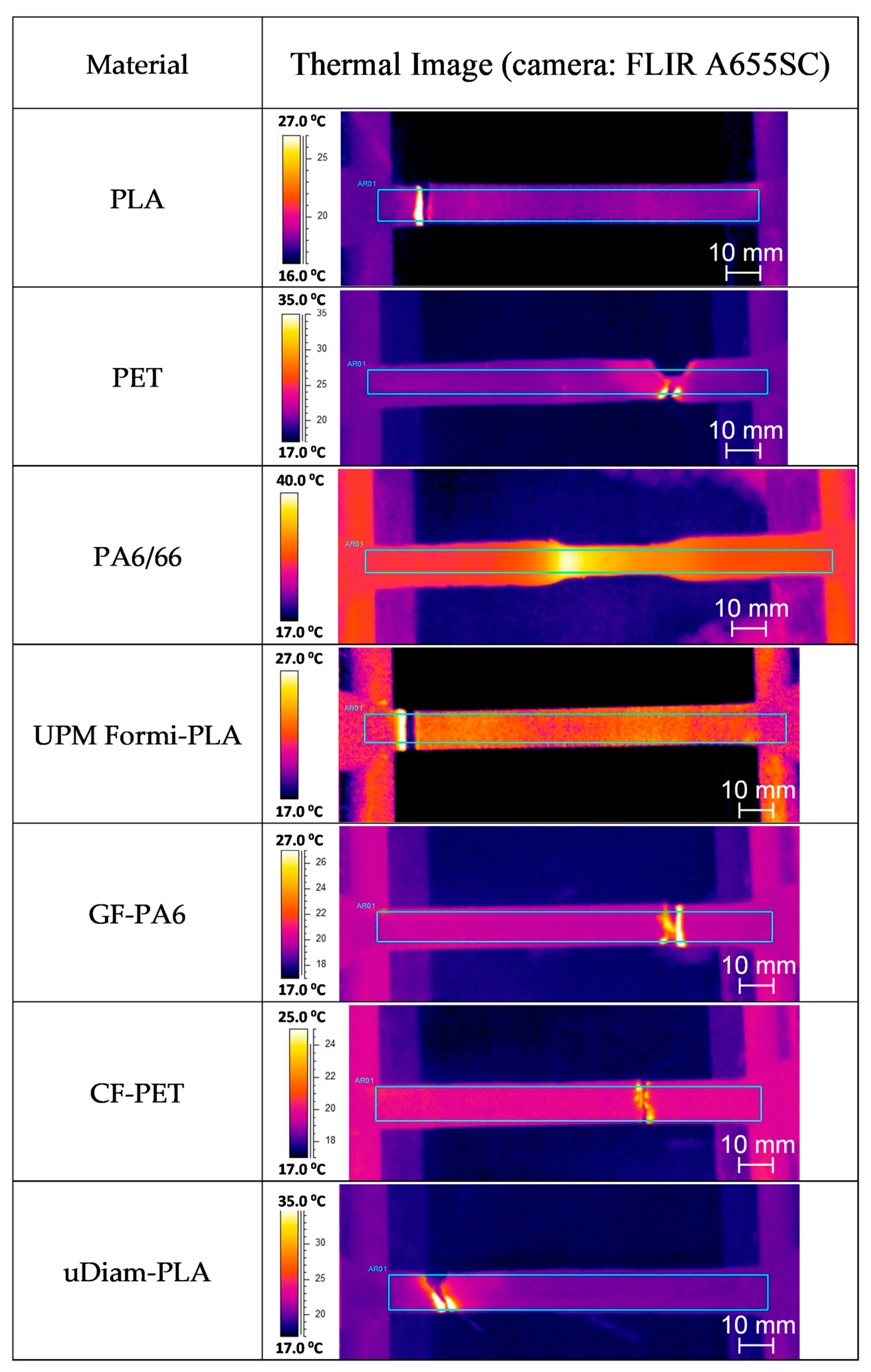
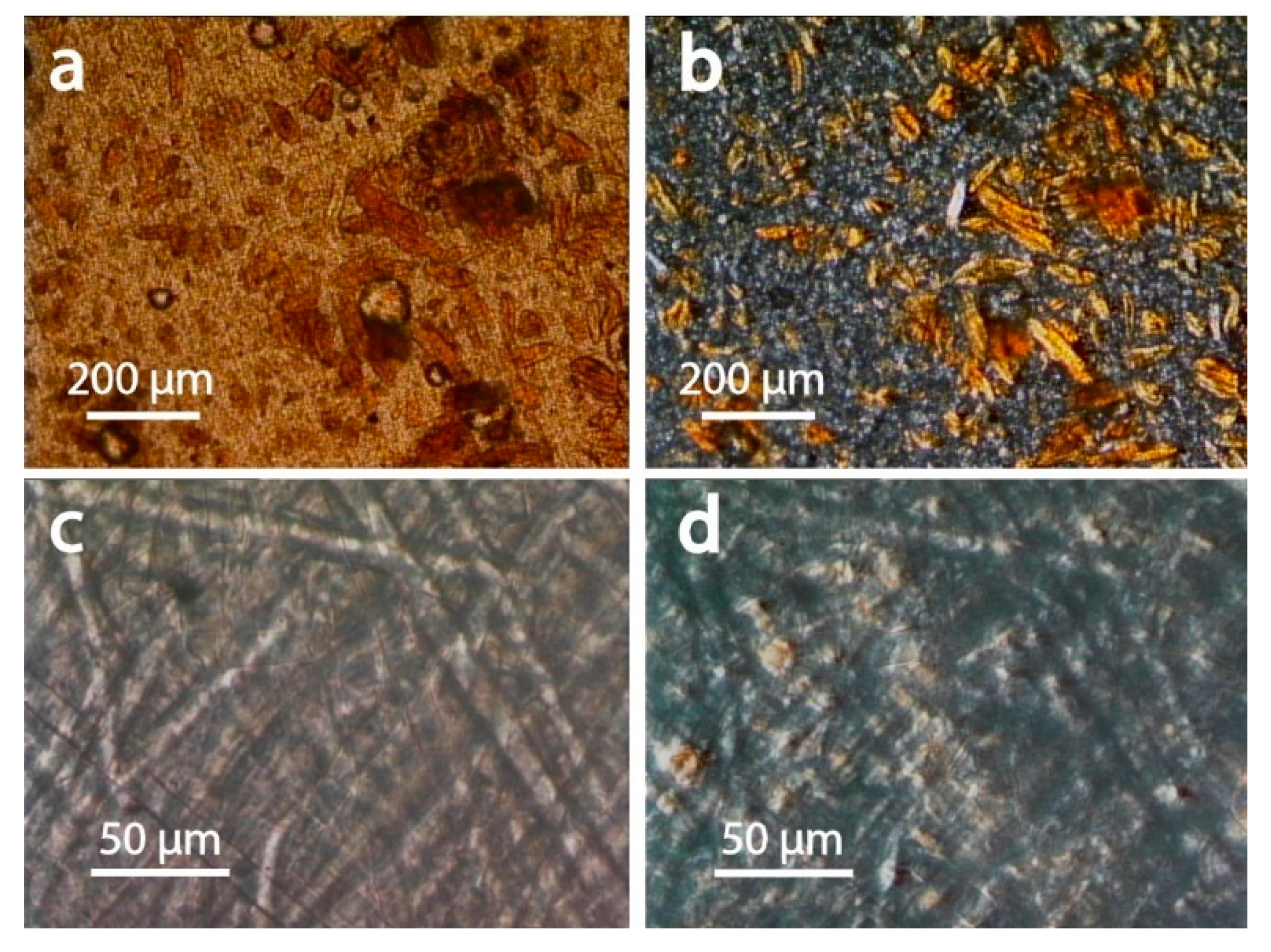
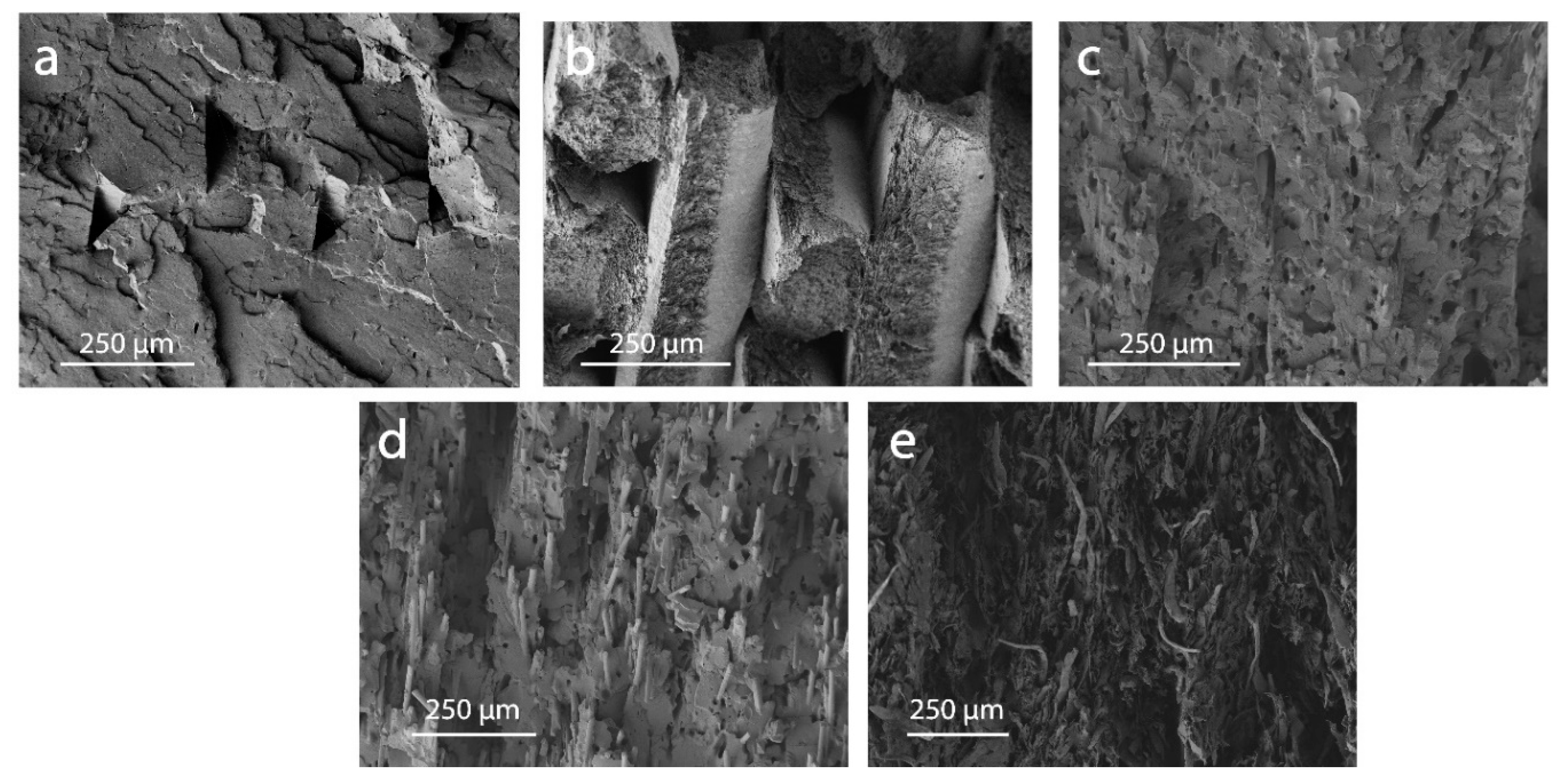
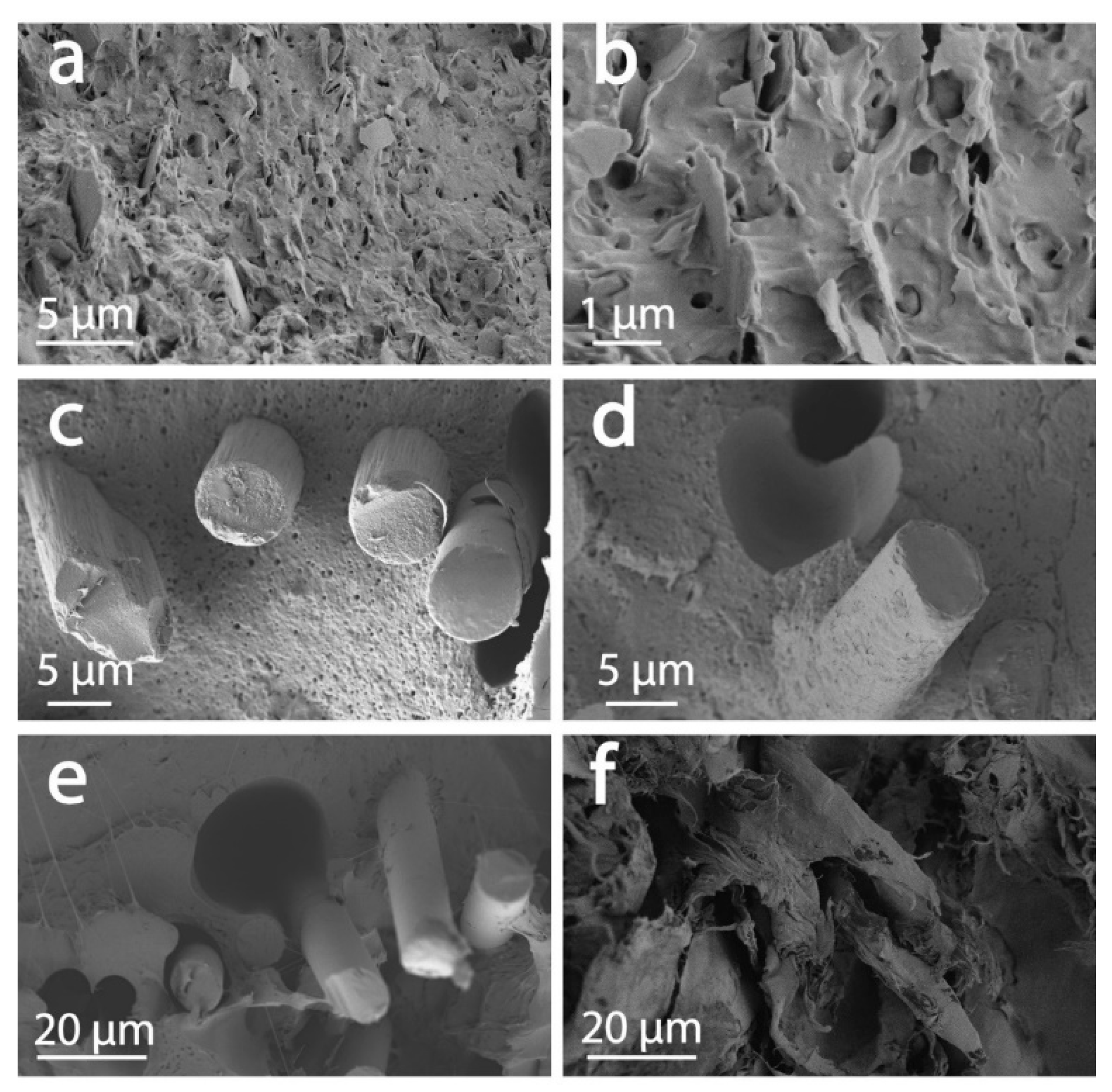
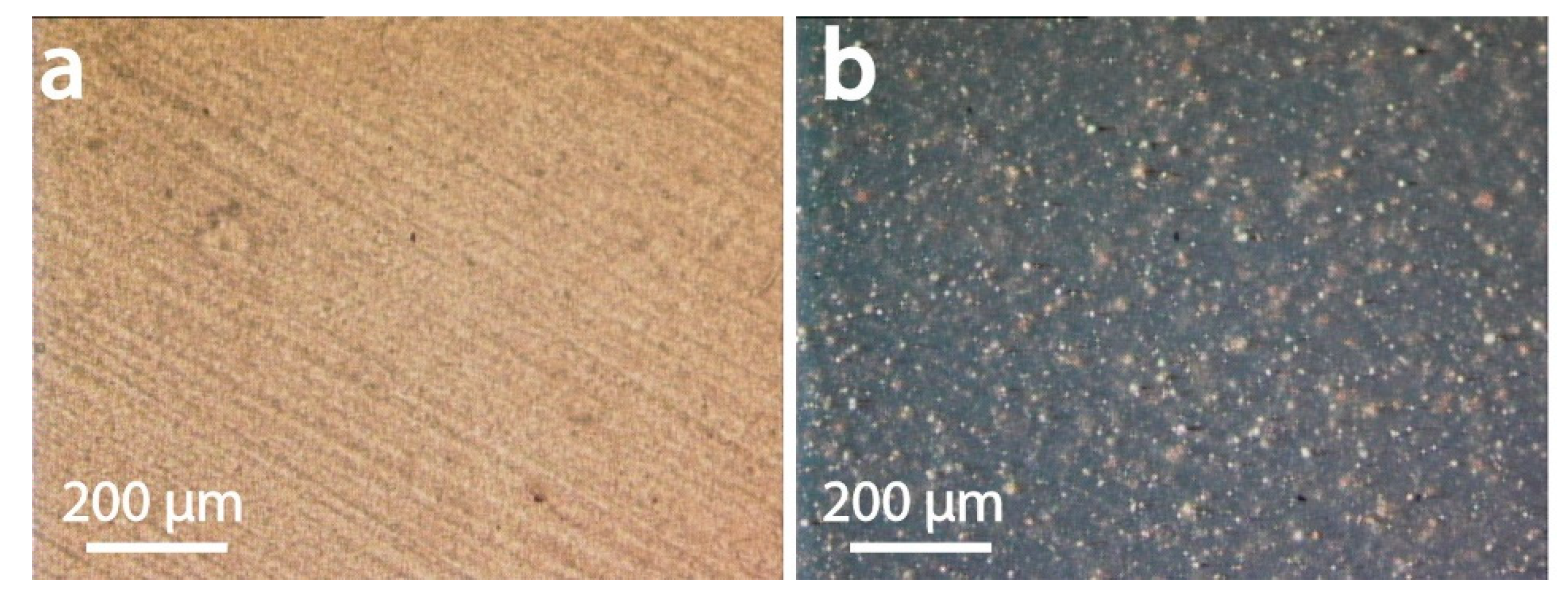
| Material Description | Abbreviation in the Text | Brand | Nozzle Temperature (°C) | Bed Temperature (°C) | Suggested Print Speed (mm/s) | Density (g/cm3) |
|---|---|---|---|---|---|---|
| Polylactic acid | PLA | Ultimaker | 210–230 | 60–75 | 40–80 | 1.24 |
| Polyamide (grade PA6/66) | PA6/66 | Ultimaker | 230–260 | 60–70 | 40–80 | 1.14 |
| Poly(ethylene terephthalate) | PET | Innofil3D | 210–230 | 75 | 40–80 | 1.34 |
| Cellulose polylactic acid | UPM Formi-PLA | Octofiber | 210–225 | 60 | 15–30 | 1.21 |
| Glass fiber polyamide (grade PA6) | GF-PA6 | Owens-Corning | 220–280 | 80–110 | 30–110 | 1.17 |
| Carbon fiber poly(ethylene terephthalate) | CF-PET | Innofil3D | 250–260 | 75 | 40–60 | 1.23 |
| Nanodiamonds polylactic acid | Udiam-PLA | Carbodeon | 220–250 | Ambient | 50–500 | 1.35 |
| Sample | WL220°C (%) | IDT (°C) | Td1 (°C) | WL1 (%) | Td2 (°C) | WL2 (%) | Td3 (°C) | WL3 (%) | Ash (%) | Filler (%) |
|---|---|---|---|---|---|---|---|---|---|---|
| PLA | 0.15 | 321.11 | 346.13 | 95.17 | 467.40 | 3.65 | - | - | 1.27 | - |
| UPM Formi-PLA | 1.10 | 310.61 | 343.28 | 85.20 | 443.05 | 13.50 | - | - | 1.20 | 14.70 a |
| Udiam-PLA | 0.87 | 334.85 | 356.61 | 81.93 | 460.48 | 3.01 | - | - | 14.62 | 14.62 b |
| PA6/66 | 1.62 | 390.34 | 440.12 | 83.15 | 520.83 | 16.56 | - | - | 0.36 | - |
| GF-PA6 | 1.07 | 393.34 | 433.75 | 62.25 | 489.70 | 8.29 | - | - | 29.50 | 29.50 c |
| PET | 0.19 | 381.47 | 420.56 | 84.24 | 526.80 | 15.59 | - | - | 0.08 | - |
| CF-PET | 0.15 | 386.08 | 423.26 | 69.97 | 508.63 | 13.18 | 698.18 | 15.358 | 0.39 | 15.74 d |
| Sample | Tg(i) (°C) | Tg(ii) (°C) | Tcc1 (°C) | ΔHcc1 (J/g) | Tm1; Tm2 (°C) | ΔHm1+2 (J/g) | Xc1F (%) | Xc13D (%) | Xc2m (%) | Tonset (°C) | Tmc1; Tmc2 (°C) | t1/2 (min) | R (min−1) |
|---|---|---|---|---|---|---|---|---|---|---|---|---|---|
| PLA | 58.76 | 58.22 | 113.99 | 18.978 | 147.78 | 21.279 | 2.46 | 22.71 | 21.30 | - | - | - | - |
| UPM Formi-PLA | 57.62 | 56.59 | 91.16 | 11.689 | 143.87; 151.57 | 23.257 | 14.47 | 29.10 | 19.71 | 40.04 | 31.38 | 0.87 | 1.15 |
| Udiam-PLA | 56.68 | 57.44 | 79.83 | 14.288 | 172.5 | 32.584 | 26.19 | 51.67 | 52.05 | 123.32 | 146.90; 116.7 | 0.66 * | 1.50 |
| PA6/66 | 46.39 | 56.78 | - | - | 180.59; 188.99 | 89.101 | 37.13 | 37.13 | 18.12 | 143.84 | 133.75 | 1.01 | 0.99 |
| GF-PA6 | 34.06 | 67.11 | - | - | 207.61 | 47.481 | 29.28 | 29.28 | 24.80 | 176.19 | 170.8 | 0.54 | 1.86 |
| PET | 65.72 | 69.13 | - | - | - | - | - | - | - | - | - | - | - |
| CF-PET | 71.79 | 74.84 | 118.64 | 21.772 | 251.57 | 32.679 | 9.96 | 29.83 | 32.18 | 216.38 | 210.55 | 0.58 | 1.72 |
| Material | Cross-Section | E | UTS | εUTS | εBreak | ΔTBreak |
|---|---|---|---|---|---|---|
| mm2 | MPa | MPa | (mm/mm) | (mm/mm) | (°C) | |
| PLA | ||||||
| (Tests) Mean | 42.39 | 1790.13 | 56.77 | 0.041 | 0.050 | 12.86 |
| (Tests) StDev. | 0.44 | 16.38 | 3.65 | 0.003 | 0.011 | 4.11 |
| (Data sheet) [15] | - | 2852.0 | 38.1 | 0.021 | 0.028 | - |
| PET | ||||||
| (Tests) Mean | 42.38 | 1607.76 | 65.64 | 0.054 | 0.067 | 27.03 |
| (Tests) StDev. | 0.57 | 52.75 | 1.03 | 0.003 | 0.001 | 9.54 |
| (Data sheet) [20] | - | 2264.0 | 40.9 | 0.030 | 0.031 | - |
| PA6/66 | ||||||
| (Tests) Mean | 41.25 | 1299.77 | 58.29 | 0.061 | - | - |
| (Tests) StDev. | 0.31 | 9.44 | 0.20 | 0.001 | - | - |
| (Data sheet) [15] | - | 579.0 | 27.8 | 0.020 | 2.10 | - |
| UPM Formi-PLA | ||||||
| (Tests) Mean | 41.89 | 809.91 | 16.69 | 0.033 | 0.038 | 5.56 |
| (Tests) StDev. | 0.15 | 30.73 | 0.38 | 0.004 | 0.004 | 1.83 |
| (Data sheet) [17] | - | 2600.0 | 28.0 | 0.050 | - | - |
| GF-PA6 | ||||||
| (Tests) Mean | 40.52 | 2533.22 | 91.16 | 0.051 | 0.051 | 14.41 |
| (Tests) StDev. | 0.13 | 19.88 | 0.78 | 0.002 | 0.002 | 2.86 |
| (Data sheet) [18] | - | 7400.0 | 102.0 | 0.021 | 0.021 | - |
| CF-PET | ||||||
| (Tests) Mean | 41.57 | 1875.49 | 52.02 | 0.037 | 0.038 | 7.73 |
| (Tests) StDev. | 0.80 | 36.34 | 1.38 | 0.020 | 0.020 | 0.58 |
| (Data sheet) [20] | - | 9000.0 | 80.0 | 0.025 | - | - |
| uDiam-PLA | ||||||
| (Tests) Mean | 41.56 | 1995.47 | 35.59 | 0.026 | 0.027 | 14.35 |
| (Tests) StDev. | 0.49 | 179.80 | 2.14 | 0.002 | 0.002 | 4.29 |
| (Data sheet) [19] | - | 6300.0 | 43.5 | - | 0.032 | - |
© 2020 by the authors. Licensee MDPI, Basel, Switzerland. This article is an open access article distributed under the terms and conditions of the Creative Commons Attribution (CC BY) license (http://creativecommons.org/licenses/by/4.0/).
Share and Cite
Karakoç, A.; Rastogi, V.K.; Isoaho, T.; Tardy, B.; Paltakari, J.; Rojas, O.J. Comparative Screening of the Structural and Thermomechanical Properties of FDM Filaments Comprising Thermoplastics Loaded with Cellulose, Carbon and Glass Fibers. Materials 2020, 13, 422. https://doi.org/10.3390/ma13020422
Karakoç A, Rastogi VK, Isoaho T, Tardy B, Paltakari J, Rojas OJ. Comparative Screening of the Structural and Thermomechanical Properties of FDM Filaments Comprising Thermoplastics Loaded with Cellulose, Carbon and Glass Fibers. Materials. 2020; 13(2):422. https://doi.org/10.3390/ma13020422
Chicago/Turabian StyleKarakoç, Alp, Vibhore K. Rastogi, Tapani Isoaho, Blaise Tardy, Jouni Paltakari, and Orlando J. Rojas. 2020. "Comparative Screening of the Structural and Thermomechanical Properties of FDM Filaments Comprising Thermoplastics Loaded with Cellulose, Carbon and Glass Fibers" Materials 13, no. 2: 422. https://doi.org/10.3390/ma13020422
APA StyleKarakoç, A., Rastogi, V. K., Isoaho, T., Tardy, B., Paltakari, J., & Rojas, O. J. (2020). Comparative Screening of the Structural and Thermomechanical Properties of FDM Filaments Comprising Thermoplastics Loaded with Cellulose, Carbon and Glass Fibers. Materials, 13(2), 422. https://doi.org/10.3390/ma13020422





